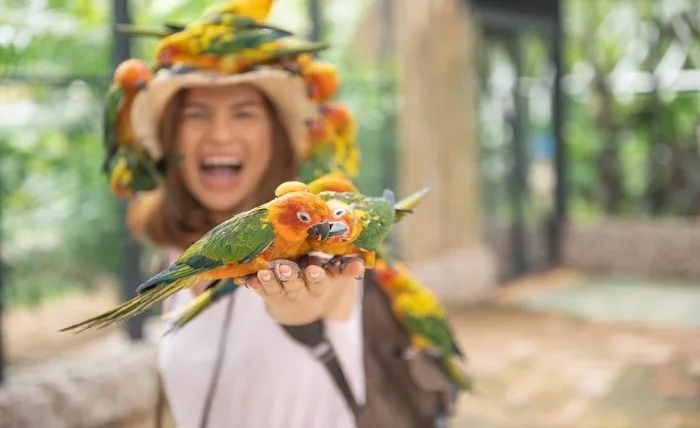Welcome to the enchanting world of parakeet training! Embarking on this journey with your feathered friend is a delightful adventure filled with chirps of joy and vibrant plumage. Discover the art of cultivating a strong bond through patient guidance and positive reinforcement. Our comprehensive guide unveils step-by-step techniques and how to train a parakeet, from teaching charming tricks to nurturing effective communication. Whether you’re a devoted pet parent or a curious novice, let’s spread your parakeet’s wings together and soar through the wondrous realm of companionship and learning.
Tips For Teach Your Parrot ToTalk
The Fascinating World of Talking Parrots
Parrots have been unique in human culture for centuries, delighting our dreams with their explicit motions and intellectual manners. Among their myriad skills, the capacity to imitate human speech is one of the most beautiful and charming traits. This special skill has led to moving and humorous interactions between parrots and their human counterparts, improving the lives of both.
Understanding Your Parrot’s Capabilities
Every parrot is unique, with varying degrees of vocalization potential. Before embarking on the journey of teaching your parrot to talk, observe its current sounds and attempts at communication. Some parrots may naturally have a greater aptitude for mimicking speech, while others might require more time and encouragement.
Creating a Positive Learning Environment
Parrots thrive in environments where they feel safe and loved. To foster a positive learning experience, create a comfortable and stimulating space for your parrot. Provide ample social interaction, mental stimulation, and physical activity to keep your feathered companion engaged and receptive to learning.
Choosing the Right Words and Phrases
Start with simple and frequently used words or phrases when teaching your parrot to talk. Greetings, common expressions, and the parrot’s name are great places to begin. Use a clear, enthusiastic tone to capture your parrot’s attention and interest.
Repetition and Reinforcement: Building Vocabulary
Like any learning process, repetition is key. Regularly repeat the chosen words and phrases, emphasizing pronunciation and rhythm. When your parrot successfully mimics a word, offer praise, treats, or positive reinforcement to strengthen the association.
Using Social Interaction as a Teaching Tool
Parrots are highly social creatures who learn from observing and interacting with human companions. Engage in regular conversations with your parrot, maintaining eye contact and using gestures to enhance understanding.
Adding Emotion and Inflection to Speech
Parrots are more likely to imitate speech that carries emotion and enthusiasm. Speak animatedly and expressively, incorporating laughter, excitement, and tenderness into your interactions. Help your parrot improve articulation and pronunciation by speaking clearly and enunciating words. Over time, they may refine their mimicry to sound even more accurate.
Utilizing Audio Aids and Recordings
Incorporate audio aids or recordings of human speech to expose your parrot to a wider range of voices and accents. Hearing different tones and patterns can help expand their repertoire of sounds.
Avoiding Common Mistakes
Avoid negative reinforcement or scolding when your parrot doesn’t get a word right. This can discourage learning and create anxiety. Stay patient and maintain a positive atmosphere. Each parrot has a unique personality and preferences. Some might enjoy whistling tunes, while others might prefer imitating household sounds. Observe your parrot’s inclinations and tailor your training approach accordingly.
Dealing with Shyness and Fear
Some parrots may be initially shy or fearful. Gradually build trust through gentle interactions and consistent routines. Never force your parrot to talk; let them progress at their own pace.
Training Young Parrots vs. Older Ones
Teaching young parrots is often easier, as they are more receptive to new experiences. Older parrots can still learn but might require more patience and time.
Mental Stimulation and Enrichment
Beyond words, provide mental stimulation and enrichment for your parrot. Offer puzzle toys, rotate cage accessories, and introduce new objects to keep their mind active. A stimulated parrot is more likely to engage in vocalization.
Addressing Frustration and Setbacks
Not all parrots will become fluent speakers, and setbacks are normal. If you encounter challenges, take a step back, reassess your approach, and maintain a positive attitude.
Celebrating Achievements and Progress
Celebrate even small victories. When your parrot masters a new word or phrase, acknowledge their accomplishment with treats, praise, and affection. Before diving into training, establish a strong bond of trust with your parrot. Spend quality time with them, offering treats and gentle interactions. A parrot that feels secure and connected to you is likelier to engage in learning and mimicry.
Ensuring Long-Term Language Retention
Consistent practice is key to maintaining your parrot’s linguistic skills. Engage in daily conversations and continue reinforcing their vocabulary to ensure long-term retention.
FAQs (Frequently Asked Questions)
- What if my parrot mimics sounds other than words?
Parrots often mimic sounds they hear in their environment. To encourage speech, focus on repeating clear words and phrases consistently.
- How long does it take for a parrot to learn to talk?
The learning process varies widely. Some parrots may start mimicking within weeks, while others may take several months to utter their first words.
- Is it possible to teach an older parrot entirely new words?
Older parrots can learn new words, which might require more repetition and patience. Stick to a consistent training routine for the best results.
Wrapping Up:
In conclusion, embarking on the journey to teach your parrot to talk is not just about imparting language skills – it’s a delightful adventure that deepens your connection with your feathered companion. As you witness your parrot utter their first words or mimic your phrases, you’ll experience a sense of pride and joy that only a parrot parent can understand. With patience, love, and the pro tips shared here, you’re not just teaching your parrot to talk – nurturing a unique and heartwarming form of communication that will enrich your lives for years to come.


